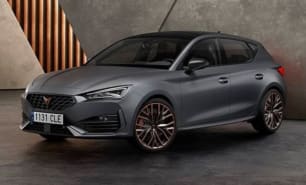Once standard setters, VW interiors have copped flak lately, losing the lead they once enjoyed in terms of perceived quality and functionality. A big backward step.
Within this context, the Leon's cabin is as aesthetically appealing as the exterior's, with lots of interesting angles and textures set within a broadly familiar VW-corporate multi-level dashboard design and presentation.
Most of the basics are largely fine, too. From the superbly enveloping front bucket seats and commanding driving position, to excellent ventilation and plenty of storage, there's much to commend.
The same goes for the moody, techy ambience, though it's closer to ‘chilled Audi' than ‘zesty Latin' in flavour.
Directly ahead of the driver is a 10.25-inch instrument cluster, offering several combinations of vehicle speed/operation and multimedia views.
Some of it looks good, some suffers from info-overload, but at least it's all configurable. Pick your favourite. And build quality seems up to scratch, too.
Like the Golf, there's also above-average space for longer legs and outstretched arms, while – after having to duck down a bit to get in – head and shoulder room are sufficient.
Selecting gears is a matter of manipulating a charmless stubby toggle. It works well enough, but remember when VW Group owners could interact with a Tiptronic-style lever and feel more immersed in the driving process? Memories.
That's replaced by paddle shifters, a divisive substitute that's of debatable merit in an electrified vehicle such as this, since they would serve better as regenerative braking controls.
But that's only the beginning of the confusion that ensues in the Cupra.
Reach for the 12-inch touchscreen to scroll through your many and varied media options, try and figure out the trip computer or search for an odometer reading, and any goodwill earned will be severely curtailed by just how needlessly complicated these and other once-simple tasks have become.
Plus, frustratingly, our particular car's multimedia system would just switch off mid-operation. This is not good.
We're certain time and familiarity will help make sense of working out where everything is and how to access vehicle functions located within layers of that touchscreen's myriad menus, but it is distracting and complicated.
And how is it that we could not find how to switch on nighttime illumination for the climate controls? In a week we failed to find that answer. And who ever green-lit fiddly slide controls over good old buttons? It's maddeningly frustrating.
Moving to the back seat, the Leon makes up some ground.
Two larger adults should settle into the outboard positions comfortably and snugly, aided by a pair of rear-facing air vents accompanied by a climate-control panel, two USB-C ports, a folding centre armrest with cupholders, ski-port access to the boot and useful storage via door bins and map pockets. There's even enough space for a third, smaller passenger to squeeze in between.
Further back, while the boot floor is long and flat and with a large tailgate opening to aid loading stuff in and out, the actual cargo capacity is just 270 litres, or nearly one-third down on the regular petrol Leon grades' 380L offering. This is due to the battery pack and related EV gubbins.
Speaking of which, if you need to carry charging cables there's nowhere to properly store them other than in the main boot area. And don't forget, there's no spare wheel.
At least there's a sturdy parcel shelf to keep prying eyes from seeing what you're carting around.
The VZe's interior, then, is spacious and broadly sensibly executed, but is let down – and mostly unnecessarily so – by some of the details. We strongly recommend trying before buying.
















































